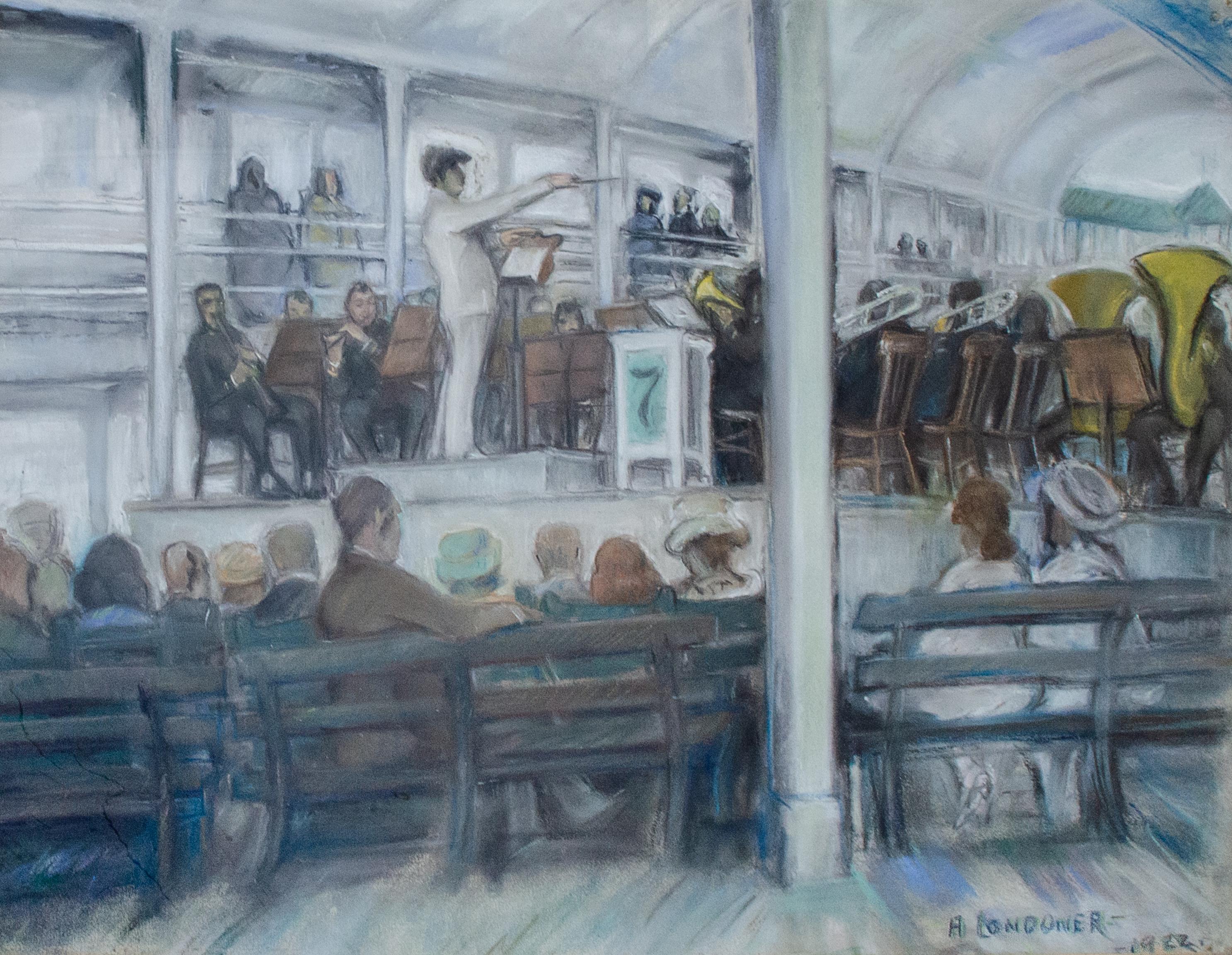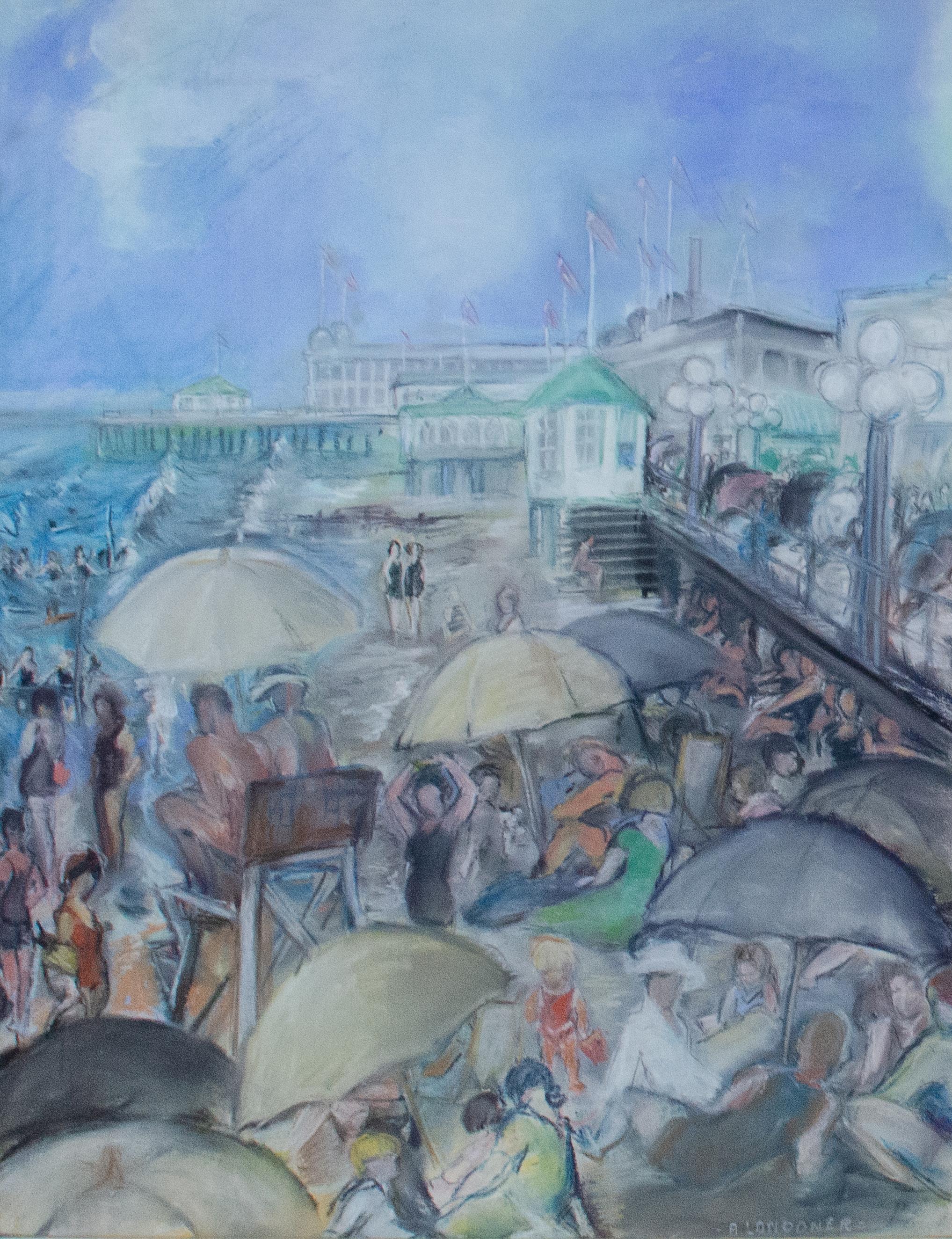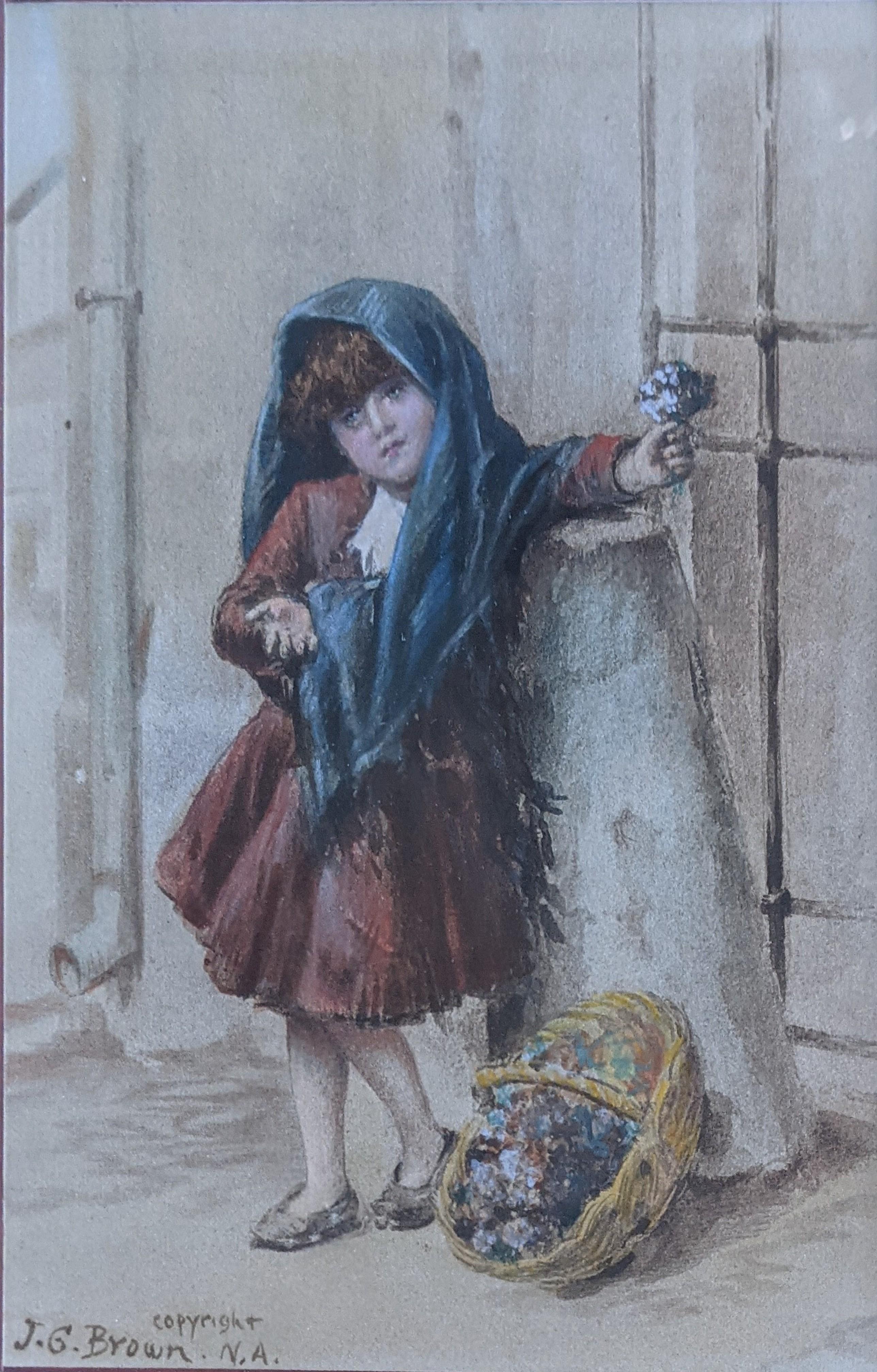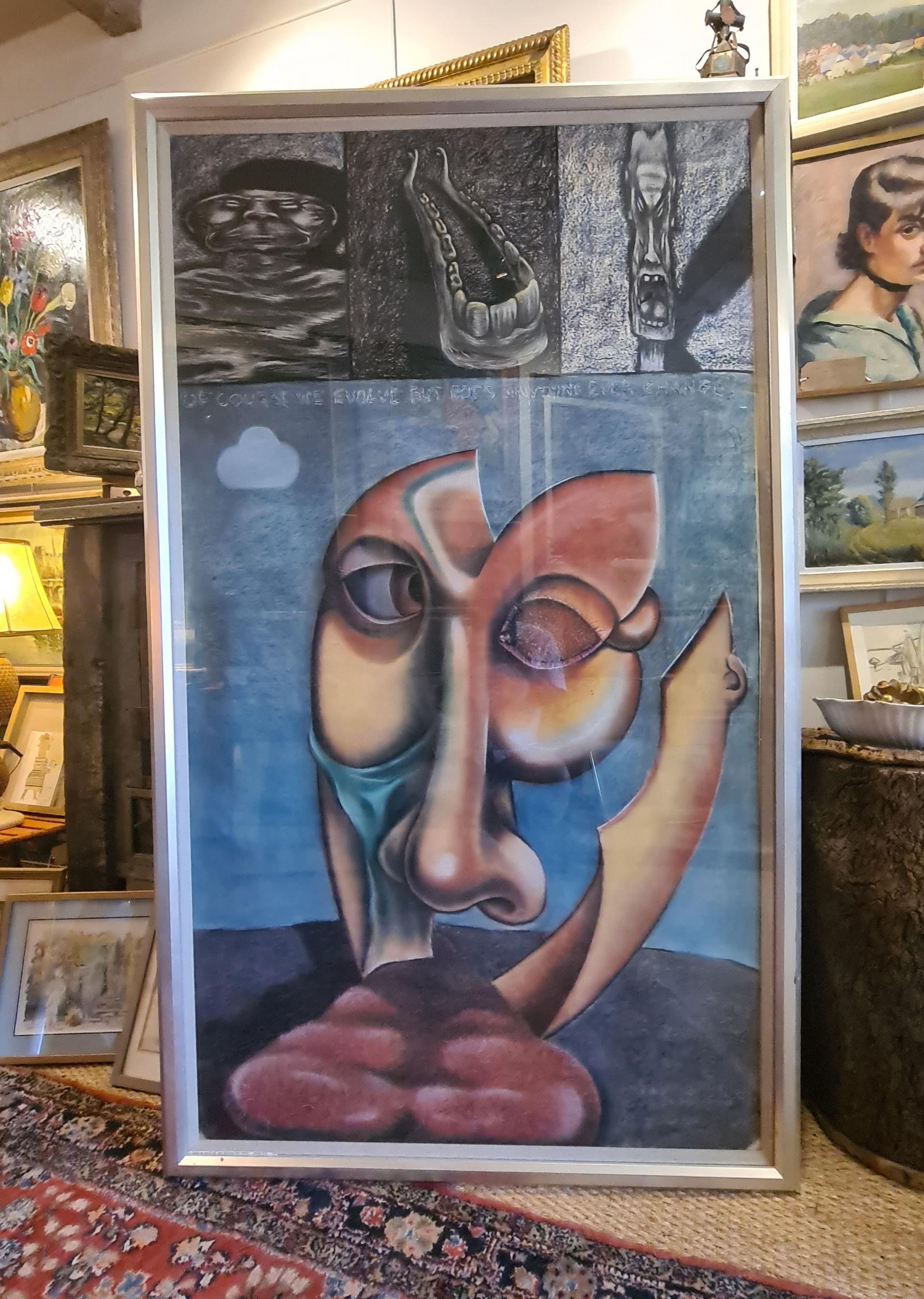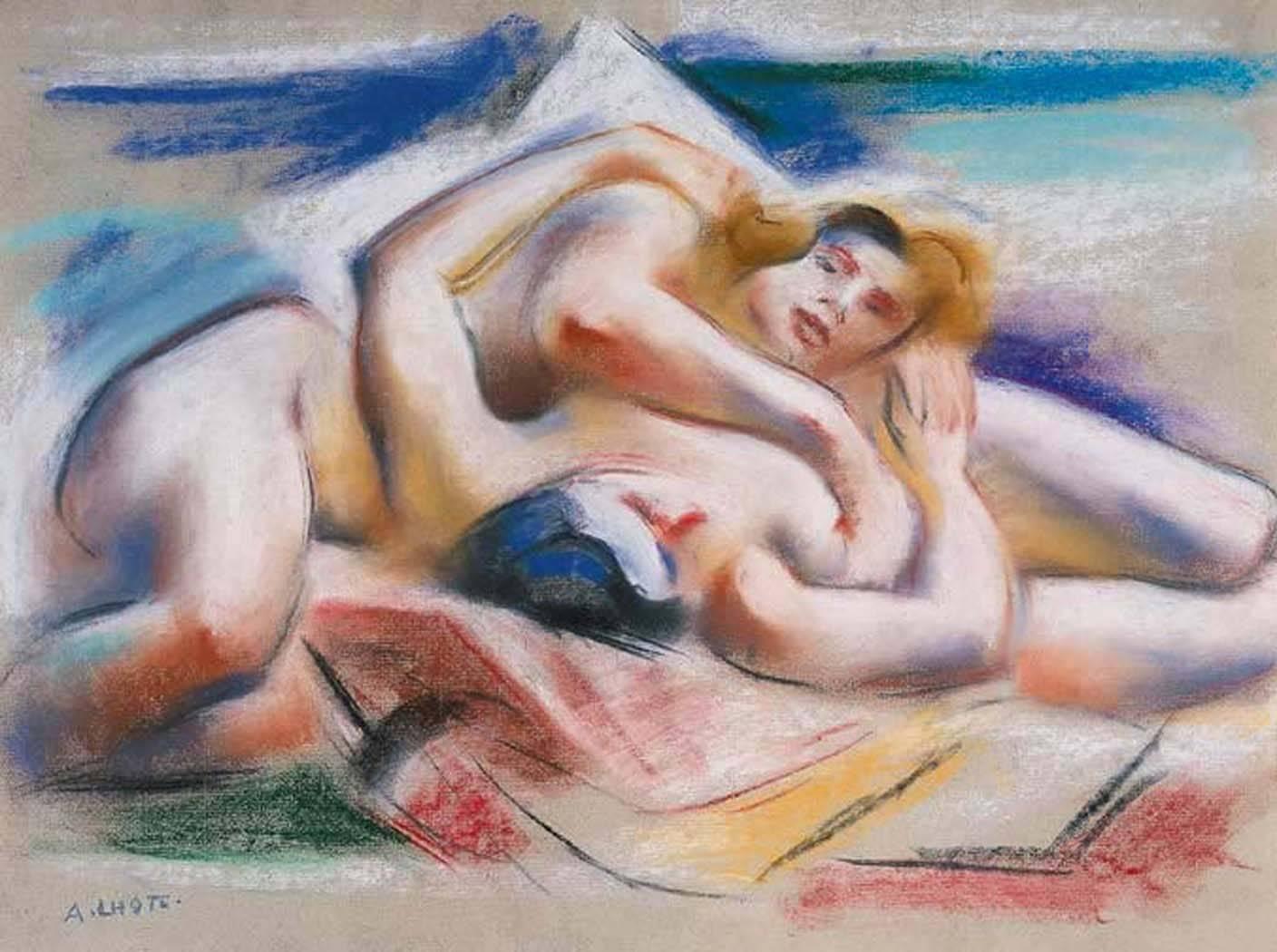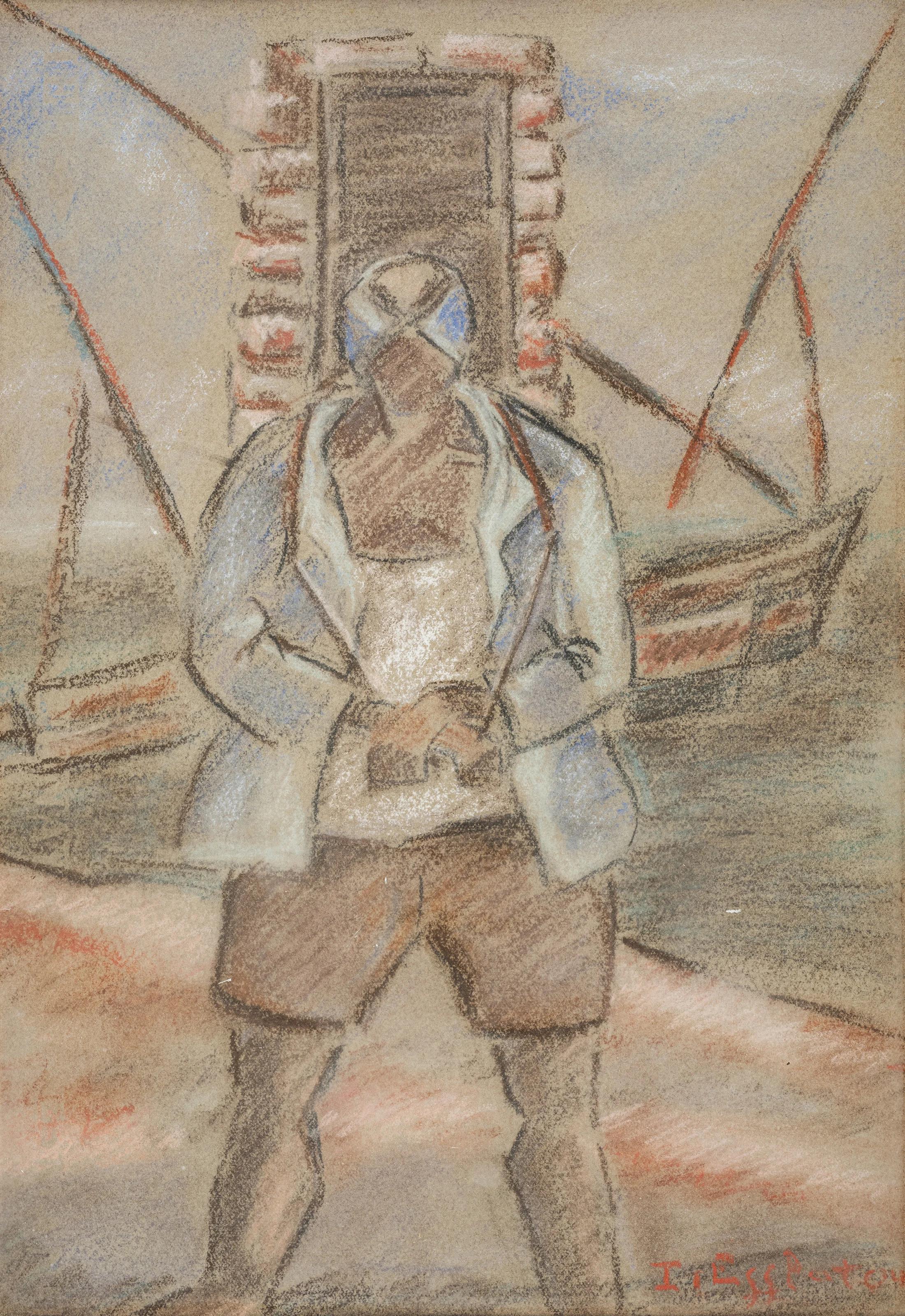Items Similar to "Night Stroll" Amy Londoner, Ashcan School, Figurative Nocturne
Want more images or videos?
Request additional images or videos from the seller
1 of 13
Amy Londoner"Night Stroll" Amy Londoner, Ashcan School, Figurative Nocturnecirca 1915
circa 1915
About the Item
Amy Londoner
Beach at Atlantic City, circa 1922
Signed lower right
Pastel on paper
Sight 23 x 18 inches
Amy Londoner (April 12, 1875 – 1951) was an American painter who exhibited at the 1913 Armory Show. One of the first students of the Henri School of Art in 1909. Prior to the Armory Show of 1913, Amy Londoner and her classmates studied with "Ashcan" painter Robert Henri at the Henri School of Art in New York, N.Y. One notable oil painting, 'The Vase', was painted by both Henri and Londoner.
Londoner was born in Lexington, Missouri on April 12, 1875. Her parents were Moses and Rebecca Londoner, who moved to Leadville, Colorado, by 1880. In 1899, Amy took responsibility for her father who had come to Los Angeles from Leadville and had mental issues. By 1900, Amy was living with her parents and sister, Blanche, in the vicinity of Leadville, Denver, Colorado. While little was written about her early life, Denver City directories indicated that nineteenth-century members of the family were merchants, with family ties to New York, N.Y. The family had a male servant. Londoner traveled with her mother to England in 1907 then shortly later, both returned to New York in 1909. Londoner was 34 years old at the time, and, according to standards of the day, should have married and raised a family long before. Instead, she enrolled as one of the first students at the Henri School of Art in 1909.
At the Henri School, Londoner established friendships with Carl Sprinchorn (1887-1971), a young Swedish immigrant, and Edith Reynolds (1883-1964), daughter of wealthy industrialist family from Wilkes-Barre, PA. Londoner's correspondence, which often included references to Blanche, listed the sisters' primary address as the Hotel Endicott at 81st Street and Columbus Avenue, NYC. Other correspondence also reached Londoner in the city via Mrs. Theodore Bernstein at 252 West 74th Street; 102 West 73rd Street; and the Independent School of Art at 1947 Broadway. In 1911, Londoner vacationed at the Hotel Trexler in Atlantic City, NJ. As indicated by an undated photograph, Londoner also spent time with Edith Reynolds and Robert Henri at 'The Pines', the Reynolds family estate in Bear Creek, PA.
Through her connections with the Henri School, Londoner entered progressive social and professional circles. Henri's admonition, phrased in the vocabulary of his historical time period, that one must become a "man" first and an artist second, attracted both male and female students to classes where development of unique personal styles, tailored to convey individual insights and experiences, was prized above the mastery of standardized, technical skill. Far from being dilettantes, women students at the Henri School were daring individuals willing to challenge tradition. As noted by former student Helen Appleton Read, "it was a mark of defiance,to join the radical Henri group."
As Henri offered educational alternatives for women artists, he initiated exhibition opportunities for them as well. Troubled by the exclusion of work by younger artists from annual exhibitions at the National Academy of Design, Henri was instrumental in organizing the no-jury, no-prize Exhibition of Independent Artists in 1910. About half of the 103 artists included in the exhibition were or had been Henri students, while twenty of the twenty-six women exhibiting had studied with Henri. Among the exhibition's 631 pieces, nine were by Amy Londoner, including the notorious 'Lady with a Headache'. Similarly, fourteen of Henri's women students exhibited in the groundbreaking Armory Show of 1913, forming about eight percent of the American exhibitors and one-third of American women exhibitors. Of the nine documented works submitted by Londoner, five were rejected, while four pastels of Atlantic City beach scenes, including 'The Beach Umbrellas' now in the Remington Collection, were displayed.
Following Henri's example, Londoner served as an art instructor for younger students at the Modern School, whose only requirement was to genuinely draw what they pleased. The work of dancer Isadora Duncan, another artist devoted to the ideals of a liberal education, was also lauded by the Modern School. Henri, who long admired Duncan and invited members of her troupe to model for his classes, wrote an appreciation of her for the Modern School journal in 1915. She was also the subject of Londoner's pastel Isadora Duncan and the Children: Praise Ye the Lord with Dance. In 1914, Londoner traveled to France to spend summer abroad, living at 99 rue Notre Dames des Champs, Paris, France. As the tenets of European modernism spread throughout the United States, Londoner showed regularly at venues which a new generation of artists considered increasingly passe, including the annual Society of Independent Artists' exhibitions between 1918 and 1934, and the Salons of America exhibition in 1922. Londoner also exhibited at the Morton Gallery, Opportunity Gallery, Leonard Clayton Gallery and Brownell-Lambertson Galleries in NYC. Her painting of a 'Blond Girl' was one of two works included in the College Art Associations Traveling Exhibition of 1929, which toured colleges across the country to broad acclaim.
Londoner later in life suffered from illnesses then suffered a stroke which resulted in medical bills significantly mounting over the years that her old friends from the Henri School, including Carl Sprinchorn, Florence Dreyfous, Florence Barley, and Josephine Nivison Hopper, scrambled to raise funds and find suitable long-term care facilities for Londoner. Londoner later joined Reynolds in Bear Creek, PA. Always known for her keen wit, Londoner retained her humor and concern for her works even during her illness, noting that "if anything happens to the Endicott, I guess they will just throw them out." Sprinchorn and Reynolds, however, did not allow this to happen. In 1960, Londoner's paintings 'Amsterdam Avenue at 74th Street' and 'The Builders' were loaned by Reynolds to a show commemorating the Fiftieth Anniversary of the Exhibition of Independent Artists in 1910, presented at the Delaware Art Center, Wilmington, DE. In the late 80's, Francis William Remington, 'Bill Remington', of Bear Creek Village PA, along with his neighbor and artist Frances Anstett Brennan, both had profound admiration for Amy Londoner's art work and accomplishments as a woman who played a significant role in the Ashcan movement. Remington acquired a significant number of Londoner's artwork along with Frances Anstett Brenan that later was part of an exhibition of Londoner's artwork in April 15 of 2007, at the Hope Horn Gallery, The University of Scranton, PA. We thank the detailed research and texts to accompany the exhibition compiled and edited by Darlene Miller-Lanning, PH.D, that brought Londoner's life story to those who follow the Ashcan movement.
She studied art in New York City with Robert Henri and John Sloan. She was one of the women artists of the Ash Can School, several of whom also studied with Robert Henri, like Bessie Marsh.
Londoner was one of the artists who exhibited at the 1913 Armory Show which included four of her pastel paintings entitled The Beach Crowd, Playing Ball on the Beach, The Beach Umbrellas, The Life Guards, and The Marina Grande. Between 1912 and 1914, her works were exhibited at the MacDowell Club in New York. Her works were exhibited at the Waldorf Astoria on February 25, 1921, at the Society of Independent Artists. Her works, exhibited at a Society of Independent Artists exhibition, were described as having a "rare specialization through color and a very personal note of humor.
Londoner taught art to young children at the Modern School, a school based upon the principles of Francesc Ferrer i Guàrdia. Robert Henri taught adults at the school.
She was a member of the Art Students League.
- Creator:Amy Londoner (1878-1953, American)
- Creation Year:circa 1915
- Dimensions:Height: 17.75 in (45.09 cm)Width: 14.5 in (36.83 cm)
- Medium:
- Movement & Style:
- Period:
- Condition:
- Gallery Location:New York, NY
- Reference Number:1stDibs: LU1841213812372
About the Seller
5.0
Platinum Seller
These expertly vetted sellers are 1stDibs' most experienced sellers and are rated highest by our customers.
Established in 2021
1stDibs seller since 2022
63 sales on 1stDibs
Typical response time: <1 hour
- ShippingRetrieving quote...Ships From: New York, NY
- Return PolicyA return for this item may be initiated within 3 days of delivery.
More From This SellerView All
- "Musical Conductor" Amy Londoner, Ashcan School, Figurative Concert SceneBy Amy LondonerLocated in New York, NYAmy Londoner Musical Conductor, 1922 Signed and dated lower right Pastel on paper Sight 18 x 23 inches Amy Londoner (April 12, 1875 – 1951) was an American painter who exhibited at ...Category
1920s Ashcan School Figurative Paintings
MaterialsPastel, Paper
- "Beach at Atlantic City, New Jersey" Amy Londoner, Ashcan School, FigurativeBy Amy LondonerLocated in New York, NYAmy Londoner Beach at Atlantic City, circa 1922 Signed lower right Pastel on paper Sight 23 x 18 inches Amy Londoner (April 12, 1875 – 1951) was an American painter who exhibited at...Category
1920s Ashcan School Figurative Paintings
MaterialsPastel, Paper
- "Flower Girl, " John George Brown, Genre Painting, Street FigureBy John George BrownLocated in New York, NYJohn George Brown (1831 - 1913) Flower Girl, circa 1900 Watercolor on paper 6 3/4 x 4 3/4 inches Signed lower left Period Hand Carved Foster Brothers Fram...Category
Early 1900s Ashcan School Figurative Paintings
MaterialsPaper, Watercolor
- "In Foreign Parts" Eugene Higgins, Southwestern Pueblo, Modern FigurativeBy Eugene HigginsLocated in New York, NYEugene Higgins In Foreign Parts, circa 1913 Signed lower right Watercolor on paper Sight 17 x 13 inches Born William Victor Higgins in 1884 to a Shelbyville, Indiana farm family where the only art Victor was aware of as a child was his father's love of flowers. "He loved their forms and their colors, and he tended his garden as a painter might work a canvas." At the age of nine, Victor met a young artist who traveled the Indiana countryside painting advertisements on the sides of barns. He purchased paints and brushes so the young Higgins could practice his own artwork on the inside of his father's barn. He also taught Victor about art museums and especially about the new Chicago Art Institute. This information never left the young artist, and he saved his allowance until his father allowed him at the age of fifteen to attend Chicago Art Institute. He worked a variety of jobs to finance his studies both there and at the Academy of Fine Arts. Victor Higgins traveled to New York in 1908, where he met Robert Henri, who became a significant influence by depicting every-day scenes and stressing the importance of the spirit and sense of place as important factors in painting. Higgins was also greatly affected by the New York Armory Modernism Show of Marsden Hartley in 1913. While Victor Higgins was in Chicago he met former mayor and avid collector Carter H. Harrison who was to prove instrumental in the growth of Higgins career for several years. Harrison agreed to support Higgins for four years to go to Paris and Munich and paint and study in the great museums in Europe. While at the Academie de la Grande Chaumier in Paris (1910-1914) he met Walter Ufer, who was another Chicago artist being sponsored by Carter Harrison. This meeting was not only a life-long friendship, but the beginning of a great change in the way Higgins looked at "American" art. He decided that America needed it's own authentic style rather than the 19th Century classic style he was taught in Europe. Very soon after returning to Chicago in 1914, Harrison sent him and Walter Ufer on a painting trip to Taos, New Mexico for a year in exchange for paintings. Higgins made other similar agreements and was able to support himself with his painting. This trip was a life-changing experience and introduced Higgins to the authentic America he had been looking for. In 1914 Taos was an isolated village about twelve hours from Santa Fe on an impossible dirt road. But the colorful life of the pueblo people and the natural beauty drew a collection of artists who became the Taos art colony, from which the Taos Society of Artists was founded in 1915. Victor Higgins became a permanent resident within a year of his arrival and a member of the society in 1917, exhibiting with Jane Peterson in 1925 and with Wayman Adams and Janet Scudder in 1927. The members would travel around the country introducing the Southwest scenes with great success. He remained a member until the Society's dissolution in 1927. Higgins was the youngest member of the group of seven. Other members were Joseph Henry Sharp, Bert Phillips...Category
1910s American Modern Figurative Drawings and Watercolors
MaterialsWatercolor, Paper
- "Portrait of an Italian Fencer, " John Frederick Kensett, Hudson River SchoolBy John Frederick KensettLocated in New York, NYJohn Frederick Kensett (1816 - 1872) Portrait of an Italian Fencer, circa 1845-47 Watercolor on wove paper 13 1/8 x 8 1/8 inches Signed with initials and inscribed lower right "J.F.K. Rome" From October 1845 through the spring of 1847, Kensett lived in Rome. He attended classes where he sketched from live models, and he sketched in the countryside outside Rome and around Florence, Perugia, and Venice, places he visited with his artist friends. He fulfilled commissions for paintings from Americans in Italy, and by 1847 his career was well established. Son of an English immigrant engraver, John Kensett lacked enthusiasm for that medium and became one of the most accomplished painters of the second generation of Hudson River School painters. His reputation is for Luminism, careful depiction of light, weather, and atmosphere as they affect color and texture of natural forms. He was particularly influenced by the painting of Asher Durand in that he focused on realism and detail rather than the highly dramatic views associated with Thomas Cole. Going to the western United States in the mid 1850s and the 1860s, he was the first of the Hudson River School painters to explore and paint the West. Kensett was born and raised in Cheshire, Connecticut, and learned his engraving from his father, Thomas Kensett with whom he worked in New Haven, Connecticut until 1829. He continued working until 1840 as an engraver of labels, banknotes and maps and was employed part of that time by the American Bank Note Company in New York City. There he met Thomas Rossiter, John Casilear, and other artists who urged him to pursue painting. In 1840, he and Rossiter, Asher Durand, and Casilear went to Europe where Kensett stayed for seven years and supported himself by doing engraving but became accomplished in landscape painting. Having sent canvases of Italian landscapes back to New York, he had a reputation for skillful painting that preceded him. When he returned to New York City in 1847, he was an "instant success" and very sought after by collectors. Two of his Italian landscapes had already been purchased by the American Art Union. By 1849, he was a full member of the National Academy of Design and was generally popular among his peers. His studio was a gathering place with travelers stopping by to see his canvases and to identify "precise locations in the Catskills or Newport or New England in the oil sketches and drawings that covered his walls." (Zellman 170). For the women, he was a popular bachelor, "romantic looking with high forehead and sensitive expression." (Samuels 262) He was also sought after by many organizations. Among his activities were serving on the committee to oversee the decoration of the United States Capitol in Washington DC, and becoming one of the founders of the Metropolitan Museum in New York. An inveterate traveler, Kensett spent summers on painting excursions away from New York City. One of these trips was a special painting excursion with fifteen other artists sponsored by the B & O Railroad from Baltimore, Maryland to Wheeling, West Virginia. Unlike many of the Hudson River painters...Category
1840s Hudson River School Figurative Paintings
MaterialsWatercolor, Paper
- "Untitled" Bob Thompson, Figurative Work on Paper, Black Abstract ArtistBy Bob ThompsonLocated in New York, NYBob Thompson Untitled, 1964 Felt tip pen on printed paper 11 x 20 1/2 inches Provenance: The artist Kathy Komaroff Goodman (gift from the artist) Hollis Taggart, New York Exhibited...Category
1960s Modern Figurative Drawings and Watercolors
MaterialsWatercolor, Paper
You May Also Like
- Monumental Surrealist Pastel, Of Course We Evolve But Does Anything Ever Change?Located in Cotignac, FRSurrealist, figurative large scale pastel of a deconstructed head and other elements by Gordon Muir. With original exhibition title label. Presented in fine silvered wood and fabric custom frame, under glass. A magnificent and truly monumental work of a 'deconstructed' head and three other triptych elements. Influenced by the paintings of Francis Bacon and Salvador Dali the work is intriguing and arresting at the same time. We can see how Muir gained such success later for his sculptural pieces as he is even in this work thinking in three dimensions. On closer inspection the details reveal themselves, the eyeball reminiscent of the shell of a horse chestnut, the furry surface to the tongue all in soft pastel shades. The three upper elements, in monochrome revealing the development of man. A really intriguing and strong painting that would grace any interior and be the talking point of any collection. It is very unusual to find a pastel of these proportions. The medium itself gives the work a softness creating an intriguing juxtaposition to the subject itself. Sculptor, born in Hawick, Gordon Muir was educated at art colleges in London, Scotland and the University of New Mexico, after which he spent time working with woodblock artists in Japan. He has more recently concentrated his artistic endeavours on sculpture, much of this in collaboration with the Paul Hogarth...Category
Late 20th Century Surrealist Figurative Drawings and Watercolors
MaterialsPaper, Pastel
- La PlageBy André LhoteLocated in Los Angeles, CAANDRE LHOTE "LA PLAGE" PASTEL, SIGNED FRANCE, C.1927 17.75 X 24 INCHES André Lhote 1885-1962 Lhote was born in Bordeaux, France in 1885. H...Category
1930s Cubist Figurative Paintings
MaterialsArchival Paper, Pastel
- "El Sayyad" Pastel on Paper Painting 12" x 8" inch by Inji EfflatounBy Inji EfflatounLocated in Culver City, CA"El Sayyad" Pastel on Paper Painting 12" x 8" inch by Inji Efflatoun circa 1960 Signed Inji Eflatoun pursued free studies in art. Since 1942, she has participated in the exhibitio...Category
20th Century Post-War Figurative Paintings
MaterialsArchival Paper, Pastel
- "Mass Study II", Layered paper collage and drawing, dimensional, architecturalBy Seth ClarkLocated in Philadelphia, PAThis layered paper and drawing collage titled "Mass Study II" is an original artwork by Seth Clark made of paper, charcoal, pastel, graphite, and acrylic on wood panel. Using found ...Category
21st Century and Contemporary Contemporary Figurative Paintings
MaterialsPaper, Graphite, Wood Panel, Acrylic, Pastel, Charcoal
- With Smiling Teeth, Dry Pastel on Paper by Artist Jogen Chowdhury "In StockBy Jogen ChowdhuryLocated in Kolkata, West BengalJogen Chowdhury With Smiling Teeth, Dry Pastel on Paper 7 x 9.25 inches , 2022 (unframed Size ) The framed size of the work is approx . 17 x 20 inches The work will be shipped inclusive of framing. Signed in Bengali Style : He has immense contribution in inspiring young artists of India. Jogen Chowdhury had developed his individual style after his return from Paris. His most famous paintings are in ink, watercolor and pastel. He has painted in oil medium as well. In Chowdhury’s more recent works the sensory experiences of cloth, bolsters, sofas and the human body are cross-projected to produce an uncanny world of tran-substantiated tumescence and flaccidness. Jogen Chowdhury has been widely acknowledged to be, the master of the unbroken line. Like Léger, Chowdhury has been stirred by the linear Kalighat pat tradition, but his lines are emotive and used to express and suggest the character of a person. This is done by, distorting the form without breaking the line and in the world of young, contemporary art; distortion has been Jogen Chowdhury’s most significant impact. Perhaps, because of this, a common observation of his work is that his “people” are caricatures. The person feels familiar to the viewer but it is far more individualised – the face is imaginary but the psyche or characteristics are real. The power and beauty of his technique and line is this play between the known and unknown. In Jogen Chowdhury’s work, the figure is always in the foreground, it is primary, it conveys everything. He uses colour to give volume to his figures and the fluidity of his lines bring a sensual aspect to his forms. About the Artist and his work : Born : Born 1939 in Daharpara Village, Faridpur, Bangladesh. Jogen Chowdhury is an eminent Indian painter and considered an important painter of 21st century India. Family Background : His father Pramatnath Chowdhury was a Brahmin zamindar. Both his parents took interest in art, Jogen Chowdhury’s father Pramatnath Chowdhury painted several mythological scenes from the village theatres and also sculpted various Hindu icons. Whereas his mother was an expert in Alpana drawings. 1939-47 Jogen Chowdhury lived in a village atmosphere. And after partition in 1948, the whole family shifted. Till 1951 the whole family stayed at the police department quarter of his uncle, where on the walls Jogen Chowdhury painted his first painting, 1962 Jogen Chowdhury was employed as Designer in the Handloom Board. Education : 1955-60: Studied at the Government College of Art and Crafts, Kolkata. 1965 : He went to paris to study in Ecole des Beaux Arts, in William Hayter’s Atelier 17. Professional Experience : 1968-72 : He worked as an Art-Designer, Madras Handloom Board, Madras. 1970 : A collection of his poems were published, titled ‘Hridoy Train Beje Othey’. 1987 : Joined Kala Bhavan , Santiniketan as a professor of painting. Selected Exhibitions : 1972, 1975 & 1978 respectively : I, III, IV Triennales at New Delhi. 1979: The Sao Paolo Biennale. 1980: The exhibitions at the Fukuoka Museum, Japan. 1982: The Royal Academy, London. 1982: The Hirschhorn Museum, Washington D.C. 1986: The II Havana Biennale. 1989: ‘Festival of India’, in Geneva. 2002: Saffron art...Category
2010s Modern Figurative Drawings and Watercolors
MaterialsPastel, Paper, Mixed Media
- In Isolation Series VIBy Seth ClarkLocated in Philadelphia, PAThis architectural wall-hanging artwork titled "In Isolation Series VI" is an original artwork by Seth Clark made of collage, charcoal, pastel, graphite, and acrylic on wood. This pi...Category
21st Century and Contemporary Contemporary Figurative Drawings and Water...
MaterialsWood, Paper, Charcoal, Pastel, Acrylic, Graphite
Recently Viewed
View AllMore Ways To Browse
New Hope School
School Antiques
Night City Street
New Hope School Paintings
Henri Mark
French Medical Art
Amsterdam School Style
Circa 1915 Paintings
Between Neighbors
Guess Who
Swedish School Oil Painting
The Tailor Paintings
Ashcan New York
Night Club Painting
Antique Colorado
Colorado Antique
Ash Can Art
French School Oil Paintings 1910
